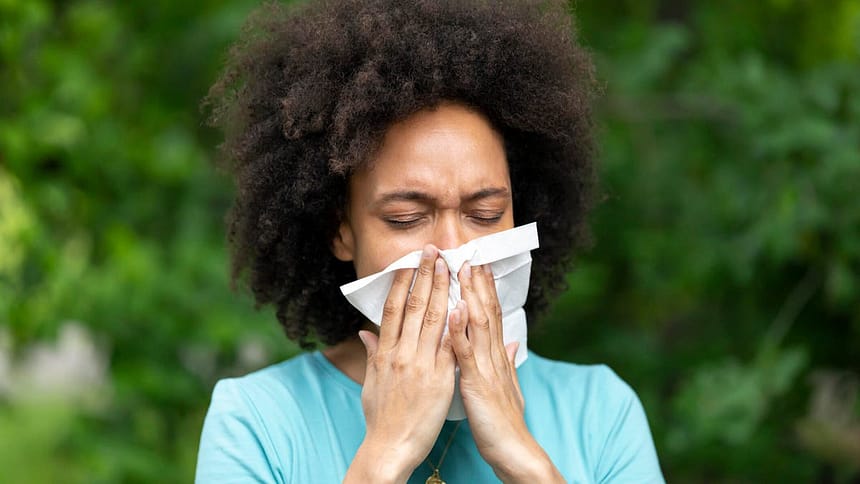If your allergies feel worse than ever, you’re not imagining it. “Seasonal allergies have intensified, partly because climate change is making pollen seasons longer and more intense,” Dr. Abie H. Mendelsohn, M.D., F.A.C.S., of the Los Angeles Center for Ear, Nose, Throat and Allergy, explains. “People with the traditional hay fever-type allergy symptoms are now [being affected by] symptoms for more weeks of the year than the decades before.”
However, you don’t have to tolerate allergies in silence. If you’re looking for ways to find allergy relief at home and antihistamines aren’t cutting it for you, you can try natural remedies and lifestyle changes. From using an air purifier to nasal saline rinses and artificial tears, these are some ways experts recommend you soothe your allergies at home.
1. Use an air purifier
“Installing air purifiers or in-home air filters helps to reduce allergens in your indoor spaces,” says Bria Collins, Au.D, CCC-A, audiologist and associate director of audiology practices at the American Speech Language and Hearing Association (ASHA).
Dr. Gene Brown of Charleston ENT Association LLC, the president-elect of the American Academy of Otolaryngology-Head and Neck Surgery, agrees, stating, “High-efficiency particulate air (HEPA) purifiers can reduce airborne allergens such as pollen, pet
dander and dust.” He adds that HEPA purifiers can be especially beneficial in high-traffic areas around the home, like bedrooms.
Dr. Pamela Georgeson of the Kenwood Allergy and Asthma Center also advises that you add HEPA filters to your HVAC systems to further reduce airborne allergens.
2. Avoid triggers
If allergies have got you down, it’s important to figure out what is triggering your allergies in the first place. Then, avoid those triggers. “Allergy testing is essential for identifying individual allergy triggers,” says Brown. “Minimizing exposure to these allergens is a foundational step in managing allergies.”
Brown lists the following strategies for steering clear of allergens:
On days when pollen counts are high, Mendelsohn advises, “Keep windows closed (use air conditioning instead) to avoid bringing pollen indoors.”
For people allergic to pets, Georgeson specifically recommends keeping pets out of your bedroom and frequent bathing and grooming of pets to reduce dander, which causes allergy symptoms. Mendelsohn adds that you should keep pets off upholstered furniture for this reason.
3. Control dust mites
Georgeson recommends putting allergen covers on your pillows and mattresses to reduce exposure to dust mites. You can also wash this bedding in hot water to kill the dust mites. Brown adds that the water should be at least 130°F or 54°C.
Brown also recommends regularly vacuuming upholstered furniture and carpets with a HEPA-filter vacuum and dusting surfaces frequently with a damp cloth.
4. Shower and change your clothes at home
If you can’t avoid going outside, especially on high-pollen days, Melanie Carver, chief mission officer of the Asthma and Allergy Foundation of America (AAFA), advises, “Take steps to reduce the amount of pollen that gets into your body and your home.” She offers the following tips for doing so:
- Wear a head covering, like a hat or scarf, to prevent pollen from getting into your hair
- Wear a mask and sunglasses, especially if you have severe symptoms
- Remove your shoes and wash your hands when you return home
- Wipe down or bathe your pets if they’ve been outside
- Keep your pets out of the bedroom
Brown also recommends showering, especially before bed, to prevent allergens from transferring to your bedding.
5. Sublingual immunotherapy
Though traditional subcutaneous immunotherapy (allergy shots) does last three to five years, it requires regular office visits. However, according to Brown, there are at-home alternatives.
“Sublingual immunotherapy (allergy drops placed under the tongue) and FDA-approved allergy tablets (containing specific allergens) offer convenient, long-term relief with the advantage of home administration,” he explains. Consult your doctor to find which is best for you and your specific allergies.
6. Clean regularly
Mendelsohn recommends cleaning your home regularly and vacuuming with a HEPA-filter vacuum to reduce indoor allergens like dust, mold and pet dander. Brown says the same, adding, “Choose non-toxic, fragrance-free cleaning products to avoid triggering allergy symptoms.”
7. Consider a dehumidifier
“Dust mites and mold thrive in humid environments,” explains Brown, recommending a dehumidifier. “Maintaining indoor humidity levels below 50% can significantly reduce allergen levels. Use a humidity monitor (readily available online) to track moisture levels, especially in bedrooms and basements.”
If you notice any moisture problems in your home, Mendelsohn advises that you investigate the cause to prevent mold growth.
8. Use nasal saline rinses
“Flushing out your nasal passages with a saltwater rinse can provide natural relief for nasal allergies,” Mendelsohn says. Using a neti pot or squeeze bottle with a sterile saline solution, you can gently wash away pollen, dust and mucus from your nose and sinuses.”
Performing a daily saline rinse, especially after being outdoors, can soothe your sinuses and clear congestion. However, Mendelsohn warns, “Just be sure to use lukewarm distilled or previously boiled lukewarm water and keep your rinsing device clean to stay healthy.”
9. Gargle with warm salt water
Dr. Tania Elliott, MD, a spokesperson for the American College of Allergy, Asthma and Immunology, suggests gargling with warm salt water because “the coarse salt can help remove allergens and physically scratch the back of the throat.”
For additional relief, Elliott states that you can boil water, add fresh ginger and drink it to reduce inflammation in the sinuses, nasal passages and lungs. Placing fresh eucalyptus in the shower can also help open up the sinuses.
10. Apply a cool or warm compress to your ears
For allergies that cause itchy or irritated ears, Collins advises applying a cool or warm compress to the ears for relief. “Inhaling steam may also help soothe and hydrate the mucous membranes in your ears, nose and throat,” she adds.
Collins emphasizes that you should never insert cotton swabs or anything small into your ear canals to relieve the itch. “This could cause further irritation to your ear canal or, if inserted too deep, could injure your eardrum,” she explains.
For individuals with ear or hearing problems caused by allergies, Collins advises that you consult a doctor — or, specifically, an ear, nose and throat (ENT) physician — to rule out other potential causes. This can include middle ear infections (for which you may need prescribed antibiotics), inner ear disorders and impacted earwax.
11. Use artificial tears for allergy-impacted eyes
In addition to applying a cool compress for itch relief, Steven T. Reed, O.D., president of the American Optometric Association (AOA), says, “Artificial tears can also dilute allergens and wash away mucous, thus reducing discomfort.”
He specifically recommends using eye drops right when allergy season begins and then regularly after that — instead of starting only when you notice symptoms. “This helps prevent histamine release and symptom exacerbation,” he explains, adding that prescription alternatives may be needed if you can’t find relief at home.
Rubbing your eyes is also a bad idea. It causes mast cells to break and histamines to be released, which makes your symptoms worse.
12. Take an oatmeal bath for skin allergies
If you have an allergic reaction on your skin, like hives or eczema patches, Mendelsohn states, “A tried-and-true method is an oatmeal bath: add colloidal oatmeal (finely ground oats) to lukewarm bathwater and soak for 10-15 minutes. This can calm itching and reduce redness on the skin.”
After the bath, Mendelsohn recommends applying a gentle, fragrance-free moisturizer or ointment (even plain coconut oil) to damp skin, so that moisture is locked in to repair the skin barrier. You should also ensure that you use mild, hypoallergenic soaps and laundry detergents to prevent chemicals or fragrances from worsening your skin allergies.
13. Maintain a healthy diet and lifestyle
Mendelsohn reminds us that getting proper sleep, maintaining a nutritious, balanced diet and reducing stress can all support your immune system, potentially making allergic reactions less severe. Collins adds that you should also ensure you drink plenty of water to stay hydrated.
“Some people also try folk remedies like consuming local honey or taking natural supplements (such as butterbur or quercetin) for allergies,” Mendelsohn states. “The evidence for these is limited, so use them with caution and check with your doctor to ensure there are no interactions with other medications or other medical issues.”
When to see a doctor for allergies
“If symptoms are affecting their ability to do the things they love and they find themselves modifying their schedules due to allergies; missing work days; symptoms not getting better with OTC meds, they should see a board-certified allergist,” explains Elliot, citing ACAAI’s allergist finder. Georgeson adds that people who have asthma or recurrent/chronic sinusitis (sinus infections) should see an allergist.
Mendelsohn also provides the following as additional signs you need to see a doctor for allergies:
- Severe or dangerous reactions: If you ever have symptoms of anaphylaxis, a life-threatening allergic reaction, treat it as an emergency. Signs of anaphylaxis include difficulty breathing, wheezing, swelling of the throat or face, severe hives, vomiting or feeling faint. In these cases, use an epinephrine auto-injector immediately if one is available and call 911. Do not try to handle severe reactions at home; prompt medical care can save a life.
- Suspected food allergies: If you suspect a food has caused an allergic reaction — for example, if you develop hives, swelling or vomiting after eating — you should consult a medical professional. Even if the reaction wasn’t severe, identifying the trigger is important because future reactions could be worse.
- Need for testing or advanced care: If you have frequent allergy symptoms and aren’t sure of the trigger — or if you want a more permanent solution — consider seeing an allergist. They can perform tests to pinpoint your specific allergens and discuss treatments like immunotherapy (allergy shots or oral tablets) that can greatly reduce your sensitivities over time.
For the ears, Collins says you should see a doctor or ENT if you have persistent ear pain, hearing loss (especially if it came on suddenly), drainage from your ears or dizziness, or if symptoms do not respond to over-the-counter management.
Reed emphasizes that regular eye and vision examinations are essential, whether you have allergies or not. “Many eye and vision problems have no obvious signs or symptoms, so you might not know a problem exists,” he explains, adding that you can use the AOA’s doctor locator.
The bottom line
Allergies are getting worse, but there are natural ways you can soothe your body at home. Consider an air purifier, nasal saline rinses, keeping pets out of your bedroom, removing your clothes and showering after returning home and avoiding allergy triggers. However, if symptoms persist or worsen, consider seeing your doctor or an allergist. For severe allergic reactions, call 911.






